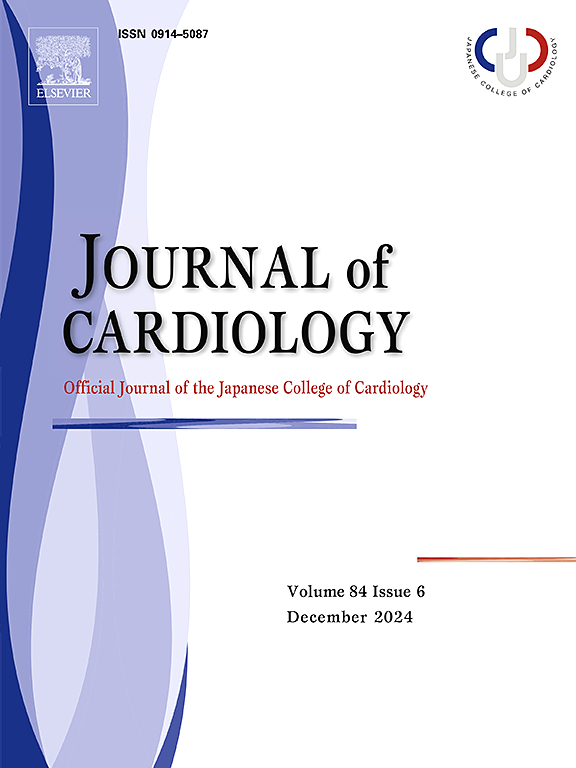准分子激光冠状动脉粥样硬化切除术治疗st段抬高型心肌梗死:来自多中心注册的见解。
IF 2.5
3区 医学
Q2 CARDIAC & CARDIOVASCULAR SYSTEMS
引用次数: 0
摘要
背景:准分子激光冠状动脉粥样硬化切除术(ELCA)用于st段抬高型心肌梗死(STEMI)的血栓性罪魁祸首病变,但其有效性尚不清楚。方法:对发病24 h内连续接受经皮冠状动脉介入治疗的患者进行回顾性调查。将患者分为ELCA组和非ELCA组。主要终点是靶血管相关的主要心脏不良事件(TV-MACE)。采用Cox回归分析和倾向评分匹配比较两组临床结果。结果:共有2593例患者纳入分析,中位随访时间为815(390-1385)天。在整个队列中,两组在无tv - mace生存率方面无显著差异。ELCA的使用对TV-MACE影响不显著(风险比1.265,95 %置信区间0.910-1.757; = 0.161页)。然而,当根据ELCA导管尺寸对ELCA组进行分层时,在单因素分析中,大导管(1.4 mm-1.7 mm)组的事件发生率低于其他组,尽管这种差异在多因素分析中并不显著。在倾向评分匹配的736例患者(368对)中,两组无tv - mace生存率无差异。结论:ELCA的使用与STEMI患者不良心脏事件发生率的降低无关。然而,使用大尺寸的ELCA导管显示出与更好的临床结果的潜在关联,值得进一步的前瞻性研究。本文章由计算机程序翻译,如有差异,请以英文原文为准。

Excimer LASER coronary atherectomy for ST-segment elevation myocardial infarction: Insights from a multicenter registry
Background
Excimer laser coronary atherectomy (ELCA) is used for thrombotic culprit lesions in ST-segment elevation myocardial infarction (STEMI), but its effectiveness is still unclear.
Methods
Consecutive patients undergoing primary percutaneous coronary intervention within 24 h of onset were retrospectively investigated. Patients were divided into ELCA and non-ELCA groups. The primary endpoint was target vessel-related major adverse cardiac events (TV-MACE). Cox regression analysis and propensity score matching were performed to compare clinical outcomes between the two groups.
Results
A total of 2593 patients were included in the analysis, with a median follow-up of 815 (390–1385) days. In the total cohort, there was no significant difference between the two groups in terms of TV-MACE-free survival rate. ELCA use was not a significant determinant of TV-MACE (hazard ratio 1.265, 95 % confidence interval, 0.910–1.757; p = 0.161). Nevertheless, when the ELCA group was stratified by the ELCA catheter size, the large catheter (1.4 mm–1.7 mm) group showed a lower event rate compared to the others in univariate analysis, although this difference was not significant in multivariate analysis. In the propensity score-matched cohort of 736 patients (368 pairs), the TV-MACE-free survival did not differ between the two groups.
Conclusions
ELCA use was not associated with a reduced rate of adverse cardiac events in patients with STEMI. However, the use of large-sized ELCA catheters showed a potential association with better clinical outcomes, warranting further prospective studies.
求助全文
通过发布文献求助,成功后即可免费获取论文全文。
去求助
来源期刊

Journal of cardiology
CARDIAC & CARDIOVASCULAR SYSTEMS-
CiteScore
4.90
自引率
8.00%
发文量
202
审稿时长
29 days
期刊介绍:
The official journal of the Japanese College of Cardiology is an international, English language, peer-reviewed journal publishing the latest findings in cardiovascular medicine. Journal of Cardiology (JC) aims to publish the highest-quality material covering original basic and clinical research on all aspects of cardiovascular disease. Topics covered include ischemic heart disease, cardiomyopathy, valvular heart disease, vascular disease, hypertension, arrhythmia, congenital heart disease, pharmacological and non-pharmacological treatment, new diagnostic techniques, and cardiovascular imaging. JC also publishes a selection of review articles, clinical trials, short communications, and important messages and letters to the editor.
 求助内容:
求助内容: 应助结果提醒方式:
应助结果提醒方式:


